Ching Lau Lauro
| Ching Lau Lauro | |
|---|---|
| Born | Cornwall, England |
| Other names |
Ching Lau Lauro Professor Ching |
| Occupation | Magic (illusion) |
| Years active | 1827–1839 |
| Known for |
(1) Possibly first in Europe to perform using limelight;[1][2] (2) First in Europe to perform aerial suspension illusion.[3][4] |
Ching Lau Lauro and Professor Ching were the stage names of a juggler and magician (1806?–1840; flourished 1827–1839) who performed outdoors and in theatres in London and the north of England. His real name is unknown, he was possibly Cornish and he was popularly known as Ching. He was the first magician in Europe to perform the aerial suspension illusion,[3][4] and possibly the first to use limelight,[1][2] and one of the earliest Western magicians to perform in Chinese costume.[3] In 1834 he played at The Theatre, Leeds.[5]
Background
Origins and identity
Little is known about the early life of the performer known as Ching Lau Lauro. His real name is unknown. He was possibly born around 1806 or even a little later, although his short career spanned 1827 to 1839. The evidence which suggests this is that he was able to perform extreme bodily contortions as part of his act throughout his career. This ability tends to be limited to youths and young adults. The same evidence would also suggest that he is unlikely to have had a previous career under a different stage name. His stage name was Ching Lau Lauro. He was also known as Professor Ching, and popularly referred-to as Ching.[6][7][8] He was not Chinese, but was possibly Cornish.[9][10] His advertisements included an act called "imitation of a Chinese juggler," and he was one of the earliest Western magicians to dress as a Chinese man.[3] In an early entertainment bill of 1827 he is promoted as a "primo buffo from Venice," however the misspelling on that playbill of "Lau" as "Law" might indicate an anglicised pronunciation of the name.[11] He was described as a "well-proportioned person."[12] This would suggest a good height and athletic build, since these represented prosperity and male attractiveness at that time.
Possible circus background
.jpg)
His particular entertainment skills might indicate that his background was among Cornish travelling showpeople who travelled and performed at circuses and fairs between March and November. Some had winter quarters in Cornwall, and some, like Ching Lau Lauro, might have been fortunate enough to perform indoors in the winter.[13] The fact that he performed "postures, equilibriums, evolutions and attitudes" in the character of a Buffo at Vauxhall Gardens in 1827, 1828 and 1834 might support this theory, since many of the Vauxhall performers were from a circus background.[14]
Private life
He died in London sometime between 19 and 26 January 1840, not long after his last performance. Since his performances required extreme gymnastic ability and contortions, he is unlikely to have been an old man when he died. His brief obituary under his stage name, copied verbatim in several newspapers, describes him as "the celebrated conjuror".[15][16][17][18] He made good money and was also sometimes a philanthropist: in 1834 he donated £4 8s 6d, the proceeds of a single day's performance, to the York Dispensary which gave medicines to the poor.[19]
Career
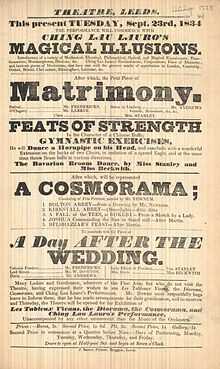
Ching Lau Lauro's advertisements and popularity lasted between 1827 and 1839, after which the brief history before his death in January 1840 is unknown. He was first advertised as a juggler and then also, from 1834, as a ventriloquist and magician. His notices included "feats of strength and gymnastic exercises" and in the 1830s he described himself as "ventriloquist, melodist, naturalist and magician."[20] Thomas Frost says that he started with posturing and balancing performances in 1828, then by 1835 he was a conjurer and ventriloquist, showing at "theatres and assembly rooms of many provincial towns, varying his entertainment with buffo songs." [9] He could "[balance] acrobatically on two chairs and [dance] the hornpipe on his head."[21] Following a fashion for representing historical scenes on stage, in the late 1830s he played Agrippa. There were many Roman Agrippas, but he may have been playing the Renaissance German magician.[22]
Aerial Suspension illusion
This was also referred to as the Broomstick Illusion or simply Suspension. From 1832 or 1833 he would juggle with balls, "sitting in the air upon nothing:" a version of the Suspension illusion.[23] At that time he omitted some of the singing from his act and added the Suspension as the climax.[9][24] Previous instances of Suspension are unknown in Europe.[3][4][8][25] The trick of "sitting in the air upon nothing" did not use a different method from Robert Houdin's Ethereal Suspension illusion, which was performed using broomsticks and an empty ether bottle more than ten years later in 1849.[26] However the originality of Robert-Houdin's magic has been descredited, and Ching Lau Lauro advertised similar feats before anyone else in Europe did.[8][24]
Performances
His act

He began his theatre career by diverting the audience with a few tricks between plays, but by 1834 he was providing the whole programme at Wolverhampton's Assembly Rooms.[25] These were on the first floor of the County Court building, built 1829 in Queen Street. The performance was in three parts. In Part I he demonstrated the Chest of Archimedes and the Column of Rosbach. These were entertaining pieces of mechanical apparatus previously shown at the Cabinet of curiosities in Paris. This was followed by numerous illusions, including A Game at Whist, Time Flies, The Wax Candles Enchanted, Elephant of Knowledge, Vulcan's Forge, Miraculous Printing, Flying Watch, Magic Bottle, Apples of Beelzebub, Magic Eggs and Loyal Metamorphose. Part II began with a ventriloquist act called Rogueries of Nicholas. He followed this by whistling various birdsong impressions.[27] This popular party piece was developed via a "variety of scenes and characters drawn from nature, introductory of His Surprising Powers of Imitation" in which he contorted his face, told stories and performed tricks of ventriloquism. In Part III he performed "feats of strength in the character of a Chinese buffo", suggesting that in Parts I and II he was most likely wearing the customary evening dress of the Victorian theatre magician, and that such a costume was less suitable for acrobatics than loose Chinese pyjamas. The strongman act was followed by "gymnastic exercises" or acrobatics involving bodily contortions with a balancing act. Last of all came the climax of the performance: the Aerial Suspension Illusion.[25] In certain theatres he used to ban sale of tickets to the gallery, because the view from there might betray the secret of the illusion.[24]
Appearances
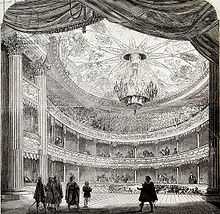
His performances are known mainly through the playbills, handbills, newspaper advertisements and theatrical reviews of the period. In 1827 he performed on 25 July at the Theatre Royal in Haymarket, and on 3 September at the New Royal Pavilion, Whitechapel Road, London.[28][29]
At some point in 1828 he appeared at the Royal Coburg Theatre between various plays, and at the Theatre Royal, Norwich.[25][30] Two playbills show that in the same year he was at the Theatre Royal, Drury Lane on 2 January, and at the Royal Pavilion, Whitechapel Road on 18 February.[31][32] On 7 July 1828 he was performing at Vauxhall Gardens.[33] His name appears in advertisements in the Times of 1828: he was performing at Sadlers Wells on 24 November, at the Adelphi Theatre and Sadlers Wells on the same night of 26 November, and at Sadlers Wells again on 1 December.[34][35][36]
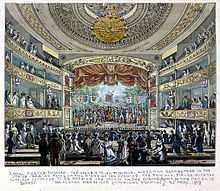
On 15 September 1830 he performed for royalty at the Brighton Pavilion.[37] On 13 February 1832 he was playing outside London, at the Royal Shakespeare Theatre at Stratford-upon-Avon.[38] This was the old Shakespeare Memorial theatre which burned down in 1826, to be replaced in April 1932, just over 100 years after Ching Lau Lauro played there. On 2 February 1833 he played at Leicester.[12] On 19 April 1834 he was playing at Huntingdon.[39] On 30 April and 1 May 1834 he was at the Chelmsford Theatre, Chelmsford.[40] In the same year he was playing at The Theatre, Leeds, West Yorkshire, on 15–19, 22 and 23 September.[41][42] At Leeds he presented his ventriloquism, a piece called "Seraglio" and some new "Surprising Feats."[43] He was booked for 10–14 November 1834 at Newcastle.[44]
On 18 and 20 February 1835 he was booked to give "his wonderful performance" at the Theatre Royal, Derby, and described as "the Pacanini (sic) of all professors in rhabdomancy, ventriloquism, imitations etc.[45] On Thursday 19 February 1835 he was expected at Repton, and on 21 February at the school room, Belper. This is possibly at the Strutt's Mansion, Green Hall.[46][47] He was booked, probably for an outdoor show, at Cambridge University in the first week of May 1836.[48] On 19 November 1836 he gave the last of several shows at the Hoop Assembly Rooms at Peterborough, after which he was to fulfil "many engagements at Bedford, Huntingdon etc."[49] He appeared at the Adelphi Theatre, Dublin, on 28 December 1837.[50] On 6 April 1838 he was in Belfast.[51] Following this he made a continental tour, returning to England at the beginning of 1839, when he performed in the suburbs of London.[6] On 16 February 1839 he appeared at Windsor Town Hall.[52]
At Herne Bay, 1836
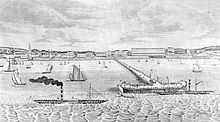
On 3 October 1836 at Herne Bay, Kent, he performed on the Pier as part of the celebrations after Ann Thwaytes laid the foundation stone of the Clock Tower.[1] This was possibly the earliest known outdoor use of limelight to illuminate a public performance. On the Pier there was . . .
. . . a new light called koniaphostic, by which the whole pier is overwhelmed with a flood of beautiful white light, in the midst of which Ching Lau Lauro will exhibit his feats in the character of a Buffo sitting in the air upon nothing, at the same time as performing various feats of juggling and standing on his head on a pole 20 feet high surrounded by showers of fire. Playbill by printer G. Smith of Herne Bay, 3 October 1836[1][2][53]
Reviews
Bad reviews
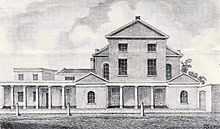
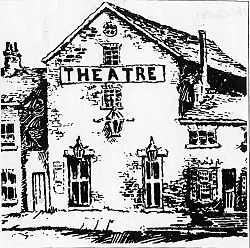
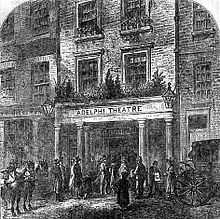
- In 1828 at the second Theatre Royal, Norwich (built 1826) his performance in Harlequinade: the Man in the Moon received a bad review from the Norfolk Chronicle:
No viler tissue of nonsensical stuff could be foisted on the patience of an insulted audience. [Here one of his characters] descended to the lowest vault of the Capulets amidst the universal hisses which such execrable trash deservedly called forth in spite of the fact that Ching Lau Lauro swallowed his own head. Norfolk Chronicle 1828[30]
Regular reviews
- On 7 July 1828 at the Vauxhall Gardens the "annual juvenile fete took place at the above fairy scene of summer amusement on Saturday evening. The weather proved fine and the company, which consisted of between five and six thousand, was most select. The gardens were illuminated by several thousand additional lamps ... Ching Lauro (sic) exhibited his feats of posture and equilibrium to the astonishing gaze of the spectators."[33]
- On 17 October 1831 the Reading Mercury reported that in Henley "this town has been visited for the last two nights by the celebrated Ching Lau Lauro who has been performing his wonderful feats of skill and agility at Reading, and he certainly deserves all the praise that has been bestowed on him. He is to perform here until Tuesday next, when he will take his benefit."[54]
- On 2 February 1833 the Leicester Chronicle said: "Ching Lau Lauro, naturalist and professor of rhabdomancy, who met with the greatest success at Drury Lane and Vauxhall Gardens, is now in this town. His ventriloquism is excellent, but his imitations of singing birds and domestic animals ar sufficient of themselves to merit the attention of the public. His feats of strength, too, are wonderful; but still more extraordinary is it, that a well-proportioned person should be able, not only to distort his limbs, but instantly to recall them to their proper position."[12]
- On 19 April 1834, the Huntingdon, Bedford and Peterborough Gazette said: This remarkable person during the four days that he has performed in this town appears to have given ample satisfaction."[39]
- On 2 May 1834, the Essex Chronicle said that at Chelmsford Theatre, Chelmsford on 30 April and 1 May:
He fully sustained the reputation which had travelled to Chelmsford before him from various parts of the kingdom. His legerdemain is right marvellous and after one or two of his tricks we fancied that a smell of sulphur pervaded the house; the lights certainly turned blue. His posturing and transformations are most extraordinary; he all but jumped down his own throat. We know not to which legion of the spirits of darkness he belongs, but at all events he is a harmless devil, and in speaking well of him we are only giving the devil his due.Repeated in Derby Mercury 18 February 1834 and in Essex Chronicle 2 May 1834[40][46]
- On 8 November 1834, the Newcastle Journal said:
This extraordinary personage, whose feats have attracted crowded audiences in almost every large town in the empire, has announced his intention of giving five performances in Newcastle, next week. Our contemporaries in Leeds, York, Manchester and other places, have been superlative in their praises of Ching, and although his name would intimate that he is from the Celestial Empire, several have not scrupled to ascribe to him rather too near an affinity with the prince of darkness. After reading their elaborate notices of astonishing feats, we incline to the latter opinion; and shall not give credence to all that is asserted, until we have had ocular demonstration. This we declared to the magician, but our scepticism is greatly removed by a perusal of testimonials from Sir Herbert Taylor (expressive of the delight of their Majesties, before whom Ching had the honour to perform) and similar letters in the hand-writing of the Earl of Denbigh the Earl of Bradford, the Marquis of Westminster, and many other Noblemen and Gentlemen. We understand Ching's arrangements will leave him sufficient leisure to attend upon private parties at the neighbouring mansions, and, as to his public performances we doubt not they will be patronized as they deserve. Numerous testimonials are left in the office of the Newcastle Journal for inspection. Newcastle Journal 8 November 1834[44]
- On 28 December 1837, the Dublin Journal at the Adelphi Theatre said that "those whose taste tends more to the wonderful cannot but feel agreeably surprised at the magic powers of Ching Lau Lauro."[50]
- On 6 April 1838 the Belfast Newsletter said:
The performances of this unrivalled Magician are still numerously attended, and the recent reduction of the admission prices has tended to increase the nightly assemblages. If amusement of the highest order be an object of attraction, we can with confidence recommend to universal notice, the pleasing variety of entertainments supplied by the talented performer in question.Belfast Newsletter 6 April 1838.[51]
- During his last year, on 16 February 1839, the Windsor and Eton Herald was quoted as saying, "The celebrated illusionist Ching Lau Lauro amused a large and respectable company at the town hall on Monday last, by his clever and inimitable performances."[52]
Prestigious commendations
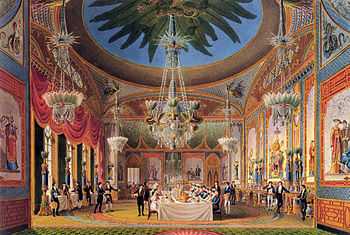
- In 1830 he performed at the Brighton Pavilion for William IV and Queen Adelaide and promptly received a letter of commendation from their secretary:
Sir, by their Majesties' command, I have to state that your various performances at the Pavilion, on the 15th of September 1830, were approved by their Majesties. I am sir your obedient servant, H. Taylor. Reproduced on a playbill, Wolverhampton 10–14 March 1834.[37]
The same playbill states that he had received similar letters of approval from the Earl of Denbigh, the Earl of Bradford and the Marquis of Westminster.[37]
References
- ↑ 1.0 1.1 1.2 1.3 Bundock 2000, p. 6.
- ↑ 2.0 2.1 2.2 See image of playbill where he is advertised to be using koniaphostic light (limelight): File:Herne Bay Museum 090.jpg
- ↑ 3.0 3.1 3.2 3.3 3.4 During 2004, p. 109.
- ↑ 4.0 4.1 4.2 Ching Lau Lauro was first to perform Aerial Suspension Illusion 1835
- ↑ Playbill for Theatre, Leeds, Monday 22 September 1834. See File:Ching Lau Lauro 1834.jpg
- ↑ 6.0 6.1 Frost 1876, p. 220-222.
- ↑ Ridgely Evans, Henry, History of Conjuring and Magic (International Brotherhood of Magicians, 1928) ASIN B000VNQZEQ Retrieved 14 December 2013
- ↑ 8.0 8.1 8.2 Magicpedia: Ching Lau Lauro Retrieved 14 December 2013
- ↑ 9.0 9.1 9.2 Frost 1876, pp. 220–222.
- ↑ Live Austioneers: Ching Lau Lauro poster of 1832 Retrieved 14 December 2013. Below the poster it says he was a Cornish ventriloquist
- ↑ Entertainments bill of New Royal Pavilion, Whitechapel Road, London, Monday 3 September 1827. See File:Ching Lau Lauro1827.jpg
- ↑ 12.0 12.1 12.2 Leicester Chronicle 2 February 1833: "The third winter concert"
- ↑ Cornwall's Diversity Action Group: A brief guide to gypsies and travellers in Cornwall (downloadable pdf file) Retrieved 14 December 2013.
- ↑ Ching Lau Lauro Retrieved 14 December 2013.
- ↑ Nichols 1840, p. 328.
- ↑ The Bury and Norwich Post, and East Anglian, Bury St Edmunds, Wednesday, 29 January 1840, Issue 3005. "Died last week"
- ↑ Stamford Mercury, Lincolnshire, 31 January 1840: Wednesday and Thursday's Posts: "Died last week"
- ↑ Cambridge Independent Press 1 February 1840: Births, Marriages & Deaths: "Died last week"
- ↑ York Herald 1 November 1834: "York Dispensary"
- ↑ The National Archives: Shropshire archives, ref. 665 Retrieved 14 December 2013.
- ↑ Schlicke 2003, p. 161.
- ↑ During 2004, p. 112.
- ↑ EB Classic Encyclopaedia 1911 Retrieved 14 December 2013. Explains the secret of how Ching Lau Lauro performed the Suspension Illusion from 1835
- ↑ 24.0 24.1 24.2 Houdini, Harry, The Unmasking of Robert-Houdin (NY, The Publishers Printing Co., 1908 Retrieved 14 December 2013. "Houdini discredits the originality of Robert-Houdin's magic"
- ↑ 25.0 25.1 25.2 25.3 Houdini, Harry, Unmasking of Robert-Houdin (New York, Publishers Printing Co., 1908) (Kindle edition: ASIN B003P9X4BA) Retrieved 14 December 2013.
- ↑ magicpedia: Aerial Suspension Retrieved 14 December 2013.
- ↑ Realistic birdsong impressions performed on YouTube, demonstrating that it is a skill, done without special props or equipment
- ↑ The Times, Wednesday, 25 July 1827; pg. 2; Issue 13340; col B Theatre Royal, Haymarket
- ↑ New Royal Pavilion, Whitechapel Road, London playbill of Monday 3 September 1827. See File:Ching Lau Lauro1827.jpg
- ↑ 30.0 30.1 Norwich Theatre Royal: A detailed history of Norwich Theatre Royal
- ↑ Playbill for Theatre Royal, Drury Lane, 2 January 1828. See File:Ching Lau Lauro 1828.jpg)
- ↑ Playbill for Royal Pavilion, Whitechapel Road, London, Tuesday 19 February 1828. See File:Ching Lau Lauro 19 Feb 1928.jpg)
- ↑ 33.0 33.1 London Standard 7 July 1828: "Royal Garden Vauxhall"
- ↑ The Times, Monday 24 November 1828; pg. 2; Issue 13758; col A "Theatre Royal, Drury-Lane This Evening," Ching Lau Lauro performs at Sadlers Wells; he is described as being "from Theatre Royal, Drury Lane, and Vauxhall."
- ↑ The Times, Wednesday 26 November 1828; pg. 2; Issue 13760; col C, "To Correspondents". He performs at Adelphi Theatre and Sadlers Wells on the same night.
- ↑ The Times, Monday 1 December 1828; pg. 2; Issue 13764; col A. Advertisement, "Sadlers Wells"
- ↑ 37.0 37.1 37.2 See File:Ching Lau Lauro 10-14 Mar 1834.jpg
- ↑ Playbill for Royal Shakespearian Theatre, Stratford-upon-Avon, Monday 13 February 1832. See File:Ching Lau Lauro 1802.jpg)
- ↑ 39.0 39.1 Huntingdon, Bedford and Peterborough Gazette 19 April 1834: "Huntingdon"
- ↑ 40.0 40.1 Essex Chronicle May 2, 1834: "Chelmsford Friday May 2nd 1834" quoted in Chelmsford Chronicle 4 May 1934
- ↑ Playbill for Theatre, Leeds, Monday 22 September 1834. See File:Ching Lau Lauro 1834.jpg)
- ↑ Playbill for Theatre, Leeds, Tuesday 23 September 1834. See File:Ching Lau Lauro 23 Sep 1834.jpg)
- ↑ Leeds Times, 13 September 1834: "Theatre, Leeds" (promotion)
- ↑ 44.0 44.1 Newcastle Journal 8 November 1834: "Local Intelligence"
- ↑ Details and image of Theatre Royal Derby (1773–1864)
- ↑ 46.0 46.1 Derby Mercury 18 February 1835: "South Derbyshire Diocesan Church building society"
- ↑ The Strutt's Mansion, Green Hall Retrieved 16 December 2013
- ↑ Cambridge Chronicle and Journal 29 April 1836: "University intelligence"
- ↑ Huntingdon, Bedford and Peterborough Gazette 19 November 1836
- ↑ 50.0 50.1 Dublin Journal 28 December 1837: "The Despot of Hanover."
- ↑ 51.0 51.1 Belfast Newsletter 6 April 1838: "Belfast waterworks bill – town meeting"
- ↑ 52.0 52.1 Berkshire Chronicle 16 February 1839, "Windsor and Eton Herald"
- ↑ The Mechanic and Chemist: A Magazine of the Arts and Sciences, p.354 Retrieved 14 December 2013. Confirms the usage of "koniaphostic light" to mean limelight.
- ↑ Reading Mercury 17 October 1831: "At a time of excitement ... "
Bibliography
- Bundock, Mike (2000). Herne Bay Clock Tower: A descriptive history. Herne Bay: Pierhead Publications. ISBN 9780953897704. Contains archive images
- During, Simon (2004). Modern Enchantments: The Cultural Power of Secular Magic. London: Harvard University Press. ISBN 9780674013711. Retrieved 12 December 2013.
- Frost, Thomas (1876). The Lives of the Conjurers. London: Tinsley Brothers. pp. 221–222. Retrieved 12 December 2013.
- Nichols, John (1840). The Gentleman's Magazine 167. F. Jeffries.
- Schlicke, Paul (2003). Dickens and Popular Entertainment. Routledge. ISBN 9780203206768.
External links
- Full text of The Lives of the Conjurors Retrieved 14 December 2013.
- Full text of The Unmasking of Robert-Houdin by Harry Houdini,1908 Retrieved 14 December 2013.
| Wikimedia Commons has media related to Ching Lau Lauro. |